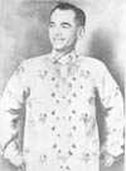HISTORY
During the Spanish occupation of the Philippines (over 300 years from 1561-1889) the barong Tagalog was required by the Spanish government for Filipinos (Indios) to be worn at most times to show the difference between the rich and the poor.. When the Spaniards colonized the Filipinos, they had to make it abundantly clear who the boss was through the imposition of a dress code. Men were not allowed to tuck their shirt tails in. That was the mark of his inferior status. Filipinos (Indios)Used in Spanish Colonial times for the ethnic Malays in the Philippines, who were not called Filipinos in Spanish Colonial times to be worn at most times to show the difference between the rich and the poor. The poor who serve the rich must always be in uniform. They are in uniform to immediately distinguish them from the employers.
After the inauguration of the Philippine Commonwealth on November 15, 1935 under the tutelage of President Manuel L. Quezon, a variation of Barong Tagalog, known as the “Commonwealth Barong Tagalog” or the Barong Tagalog with the Tydings McDuffie mottif become popular. It was so called because it featured the Philippine Commonwealth flag with the red, white and blue stripes, alongside the American flag. These two flag were crisscrossed in the design that was all over the fabric.

The Barong Tagalog gained its prestige and significance when the first Filipino President Manuel L. Quezon, declared it the National dress. The status of the fairly small inferior Barong thus became another symbol of Filipinos’ with stand to colonization.
After World War II, Philippine presidents began wearing the Barong Tagalog at their installation into office and on every formal state occasion. In contemporary times the Barong Tagalog is the power dress. As an abogado de campanilla, you cannot afford not to wear the Barong Tagalog when arguing a case in Philippine courts.

Today, every visitor and foreign dignitary invited to a Malacañang Palacealso called Palasyo ng Malakanyang, is the official residence of the President of the Philippines. state were invited to wear a Barong Tagalog, be dressed to the nines in a Barong Tagalog. The invitations specifically say come in “Barong” instead of the traditional “Coat and Tie”. Thus, every one invited to dinner at the Presidential Palace and in summit meeting venues in the country.






